
Women often struggle to realize the flat and toned midsections that they enjoyed pre-baby won't always bounce right back post-delivery, and diastasis recti may be the culprit. Diastasis recti, more commonly known as abdominal separation, leaves many women looking pregnant months, even years, after delivery. But this condition is more common than you may think.
If you’ve recently given birth and are looking to strengthen and tone your abdomen, or you’re wondering how to get rid of your “mommy tummy,” here are some key facts and helpful tips for you to keep in mind.
What is Diastasis Recti?
Diastasis recti, or abdominal separation, is a fairly common condition experienced by women during and after pregnancy, in which the right and left halves of the rectus abdominis muscle spread apart at the body’s midline.
In addition to reducing the integrity and functional strength of the abdominal wall, diastasis recti can also lead to pelvic girdle instability, causing women to experience pelvic and back pain, sacroiliac (SI) joint irritation, and restricted mobility.
Hi, I'm Cheryl. I work at Moreland OB-GYN and today I'm here to talk about diastasis recti. What is diastasis recti? It is the separation of the left and right abdominal muscles that happens during pregnancy.
Why does it happen? The connective tissue between your right and left abdominal muscle group is called the linea alba. The hormonal changes that happen during pregnancy soften connective tissue and break down the linea alba causing a protrusion of the abdominal area or a little pooch belly. Will you develop a diastasis recti? Some women will and some women won't. Women who are short or petite in nature, if you have had a separation of muscles in previous pregnancies, you're most likely to develop it again, or if you've had previous medical conditions. If you're a previous exerciser and have strong muscles, that will help you to prevent any weakness as baby grows. It's also encouraged to perform the "log roll" maneuver in bed before getting up. I hope you have found this video and instructions useful. It is our mission at Moreland OB-GYN to lead you to better health.
What Causes Diastasis Recti?
During pregnancy, widening and thinning of the midline abdominal tissue occurs in response to the force of the growing uterus pushing against the abdominal wall. This, combined with pregnancy hormones that soften connective tissue, creates a small amount of widening of the midline and is normal.
Diastasis recti occurs in approximately 30-percent of all pregnancies and can develop anytime in the latter half of pregnancy. However, the condition is most commonly seen after pregnancy when the abdominal wall is lax, and the thinner midline tissue no longer provides adequate support for the torso and internal organs.
Those at the greatest risk of diastasis recti include:
- Women who are expecting more than one baby
- Petite women
- Women with a visible sway back and those with poor abdominal muscle tone
- Women who are considered obese
However, genetics also plays a significant role in determining whether your abdominal muscles will separate. For most women, it’s simply how their bodies respond to pregnancy.
How Do I Know If I Have Diastasis Recti?
A simple self-test will help you to determine if you have diastasis recti. Follow these steps:
- Lie on your back with your knees bent, and place the soles of your feet on the floor.
- Place one hand behind your head, and your other hand on your abdomen, with your fingertips across your midline, parallel with your waistline, at the level of your belly button.
- With your abdominal wall relaxed, gently press your fingertips into your abdomen.
- Roll your upper body off the floor into a “crunch,” making sure that your rib cage moves closer to your pelvis.
- Move your fingertips back and forth across your midline, feeling for the right and left sides of your rectus abdominis muscle. Test for separation at, above, and below your belly button.
If you feel a gap of more than two-and-a-half finger-widths when your rectus abdominis is fully contracted, the gap doesn’t shrink as your contract your abdominal wall, or you can see a small mound of tissue protruding along the length of your midline, you most likely have diastasis recti.
Are There Any At-Home Treatments for Diastasis Recti?
The good news is that the vast majority of women can close their midlines and flatten their abdominal walls with proper rehabilitation exercises.
Transverse Abdominis Activation
While lying on your back with your knees bent, draw your belly button in towards your spine. Contract your stomach muscles (as if coughing or sneezing) and hold this position. When this becomes easy and pain-free, move on to the next exercise.
- Repeat: 10 Times
- Hold: 3 Seconds
- Complete: 3 Sets
- Perform: 2 Times a day
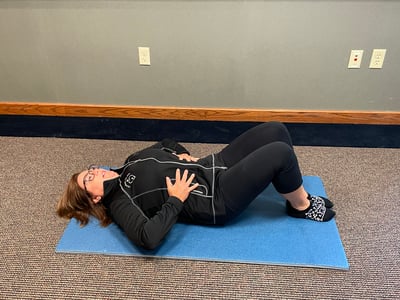
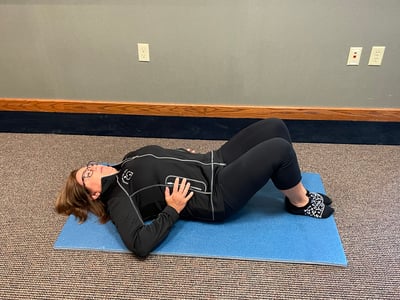
Brace Heel Slides
While lying on your back with your knees bent, perform the transverse abdominis contraction as outlined in the first exercise. Hold this position with your stomach and slowly slide your heel forward on the floor or bed and then slide it back. Use your stomach muscles to keep your spine from moving. When this becomes easy and pain-free, move on to the next exercise.
- Repeat: 10 Times
- Complete: 3 Sets
- Perform: 2 Times a day
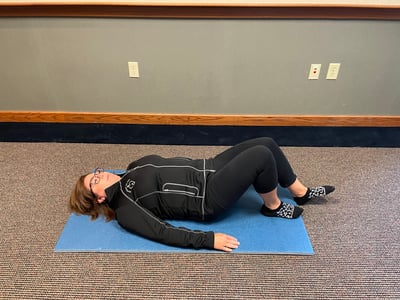
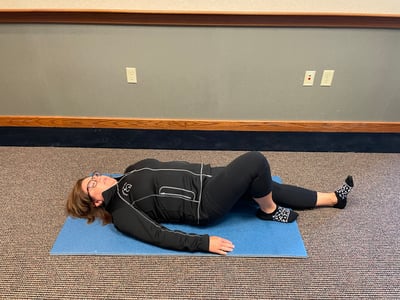
Brace Marching
While lying on your back with your knees bent, perform the transverse abdominis contraction as outlined in the first exercise. Slowly raise up one foot a few inches and then set it back down. Next, perform on your other leg. Use your stomach muscles to keep your spine from moving. When this becomes easy and pain-free, move on to the next exercise.
- Repeat: 10 Times
- Complete: 3 Sets
- Perform: 2 Times a day
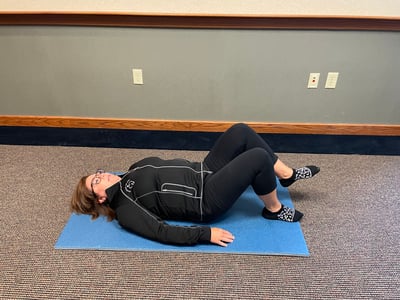
Brace Single Knee Extension
While lying on your back with knees bent, perform the transverse abdominis contraction as outlined in the first exercise. Slowly straighten out one knee while keeping the leg off the ground. Hold as indicated, then return to original position. Next, perform on the other leg. Keep your stomach muscles contracted.
- Repeat: 10 Times
- Complete: 3 Sets
- Perform: 1 Time a day
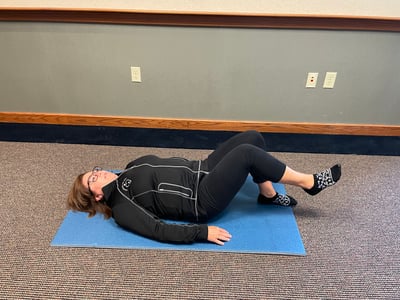
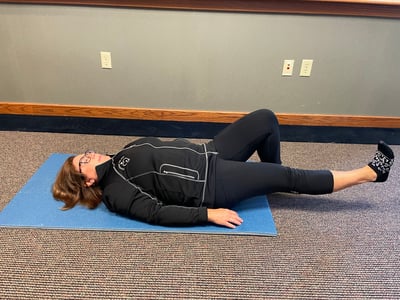
When Do I Need to See My Doctor for Diastasis Recti?
 In extreme cases of diastasis recti, abdominal tissue may tear, which may cause internal organs to poke out of the opening, also known as a hernia. In severe cases, the protruding organ may become strangulated, causing the blood supply to get cut off, which may lead to infection and tissue death. If you suspect you have a hernia, we encourage you to see your doctor for a physical exam or other diagnostic tests.
In extreme cases of diastasis recti, abdominal tissue may tear, which may cause internal organs to poke out of the opening, also known as a hernia. In severe cases, the protruding organ may become strangulated, causing the blood supply to get cut off, which may lead to infection and tissue death. If you suspect you have a hernia, we encourage you to see your doctor for a physical exam or other diagnostic tests.
Why Choose Moreland OB-GYN?
We understand how important it is for women to “get back to normal” as soon as possible after pregnancy, and while many are comfortable diving back into their previous exercise routines, some women may need a little guidance. We’re happy to answer any questions that you have and deliver a personalized care plan tailored specifically to your needs.
At Moreland OB-GYN, we specialize in women’s health care and prioritizing the needs of our patients at all ages and stages of life. We hope you’ll connect with us to answer your questions and we hope you’ll turn to our experts as a trusted source for information.









